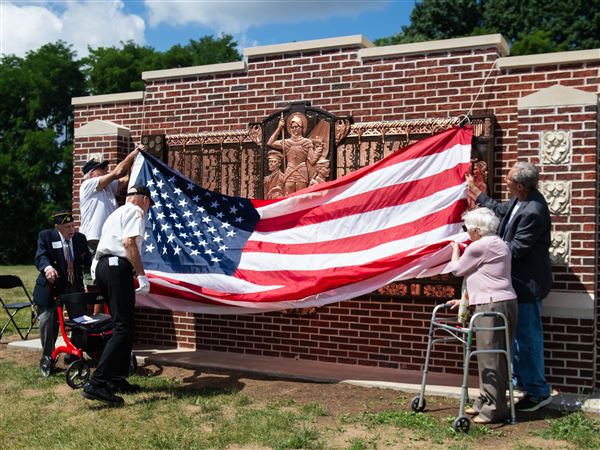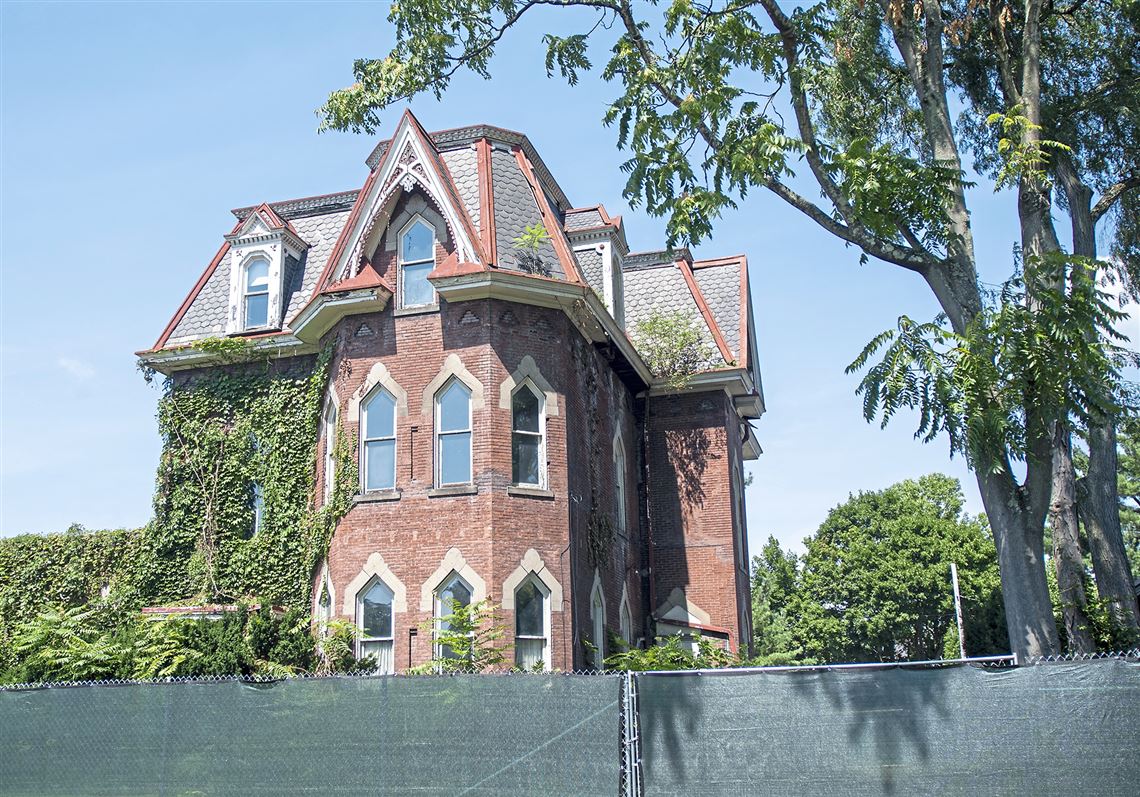Three stories high, partially dressed in ivy, sits Herbst House on Broad Street — “the gateway” into Sewickley.
One of the few Victorian Gothic structures in the area, the more than 130-year-old mansion is facing possible demolition at the hands of the Diocese of Pittsburgh.
Located at the corner of the Divine Redeemer Parish’s St. James campus, the house has been uninhabitable for decades, visibly deteriorating from water damage and overall neglect.
Parish officials are citing safety concerns in an effort to receive a permit to demolish the abandoned structure located in the borough’s Third Historic District. The destruction of the building would create more “green space” for the parish school and make for a safer environment for the community, officials said at Monday’s Historic Review Commission meeting.
At the commission meeting, the five members heard from a team from the church consisting of a legal adviser, a financial representative, an architect and parishioners, along with the parish’s pastor, the Rev. Brian Noel — before unanimously voting the effort down.
While this decision is only a negative recommendation to the council, the church will have a second opportunity for possible demolition at the borough council’s Sept. 13 meeting.
‘That’s history’
The house was built in the late 1800s and used to be a summer home to David C. Herbst of the Independent Natural Gas Co. and Standard Oil Company before it was bought by the church in 1913. The church was turned first into a Catholic school with 80 students and then later became a convent. Later, different parish ministries used the space before it was deemed unsafe in the mid-1990s, leaving it vacant for more than 30 years.
Today, parts of the roof are visibly missing, and chipped paint adorns the window frames. According to the parish, the structure is in severe disrepair primarily because of water penetration from the roof. The recent collapse of a first-floor window and known asbestos in the house further raises safety concerns for the church.
P.J. Patel, an engineer, said he conducted inspections of the house in 2008 and 2014 and recommended the building be demolished.
Church officials argued that because the house is beyond repair and is dangerous for residents to be around, it should be torn down to allow for green space for a play area for kids or more grass for their Saturday farmers market. Either would better serve the mission of the church than the standing house, the parish contends.
“The convent, the first school of St. James, that’s history,” Rev. Noel said at the Monday meeting. “That’s history for us, perhaps even more history than when the Herbert family had the house.”
He called the current condition of the mansion a “heartbreak,” but “we need that space for you all.”
The cost to rehabilitate the 13,400-square-foot-plus project would be around $2.5 million, possibly higher if inflation and the price of hiring a private developer are factored in, said Craig Rippole, president of Trinity Commercial Development.
With $511,000 in hand at the end of 2021, parishioner and finance council member Daniel Kerner told commission members that rehabilitation would be too expensive and not possible for the church.
When asked by commission members if money could be raised for the house, the team members said they believed any potential money raised would go to the mission of the church rather than property repairs.
Saving graces?
As the Herbst House faces possible demolition, Sewickley residents and preservationists recall similar cases of historic houses facing a possible fall before being saved.
In 2001, the borough rejected the proposed demolition of the Henning House by St. Stephen's Episcopal Church. The house instead got a $1.5 million makeover from St. Stephen's Church and stands today along Broad Street.
A decade later, the community rose again to protect the Pink House from demolition at the hands of the Presbyterian Church. Residents, the church and corporate sponsors raised funds to pay for a renovation that was completed in 2015.
Alan Torrance Jr., who’s providing legal services to the diocese, said demolition as a solution is a balance between what’s best for the community and what’s best for the church.
“We obviously haven’t taken this lightly,” Mr. Torrance said. “It’s not the Henning House. It's not the Pink House. We need the space, and we think we’re in a different situation than the others.
“We don’t want to tear down the house, but it's gotten to the point where we don't have a choice. … The parish has done everything possible to maintain this building.”
The Herbst House notably sits in a historic district, protecting it from facing "demolition by neglect."
Commissioner Teresa Duff pointed out that potentially allowing demolition would put the borough’s Certified Local Government status at risk. As a CLG, Sewickley has committed to national historic preservation standards, which allows it to be eligible for grant money that benefits the community.
Ms. Duff also noted that there are very few Gothic buildings throughout the county, let alone the borough.
The commission’s final vote was perhaps hinted at during a comment period in which four letters, including one from the Pittsburgh History & Landmarks Foundation, were presented in opposition and about eight speakers gave their cases for saving the house.
“Our organization is opposed to the demolition of this building, which we believe can be renovated and restored for a new use because this building is not only aesthetically beautiful and architecturally significant, but it is a contributing structure to the historic architectural environment that helps define key gateway street into the borough of Sewickley,” Pittsburgh History & Landmarks Foundation President Michael Sriprasert wrote in a letter. “Our organization stands ready to help the Divine Redeemer Parish and the Catholic Diocese of Pittsburgh think through how to renovate and adapt this building for a new use.”
Joe Zemba, a Sewickley real estate agent and the president of the Sewickley Valley Historical Society, said allowing demolition would create “a gaping hole” along Broad Street. Because the historical society sits across the street from Herbst House, Mr. Zemba said he has been watching the house sit and deteriorate — and has been concerned for quite some time.
“Funds and community efforts have been offered,” he said. “The building can become an asset to the community and the Divine Redeemer.”
Mr. Zemba said planned meetings with key stakeholders will occur leading up to the September council meeting “to start a dialogue on what can be done whether it’s for the parish or a foundation for another end user as a resident.”
He pointed out that when the church was bought in 1911, it was sold for $21,000. Today, that would be equivalent to $650,000.
“It shows what that congregation felt about the house and how wonderful would it be to get another century of use out of it,” Mr. Zemba said.
‘An absolute crime’
Heather Blane, a general contractor, told the borough commissioners that she has offered to buy Herbst House from the parish each year for the past seven years. She said specializes in historical houses and would turn the building back into a family home.
In a similar vein, Monroe “Rody” Nash, a structural engineer, said he found a client and made a proposal with property around the house in 2020 but was denied when Rev. Noel replaced the previous pastor.
Mr. Nash said he successfully renovated the houses across the street and believes the Herbst House is “very restorable.”
“It would take a lot of money, but it is possible,” he said at the meeting.
Other speakers passionately spoke about maintaining the aesthetic and history of the neighborhood.
“This house is special,” said Jeff Murray. “It’s not possible to make this house today. To knock this down would be an absolute crime.”
Sewickley Mayor George Shannon called it a difficult and emotional situation for both sides. He said he sees both arguments and that both sides are genuine in their concerns.
Since his time in Sewickley, Mr. Shannon said he can’t recall a time when the council has voted to tear a structure down. But he does not know how members will vote in September.
Hannah Wyman: hwyman@post-gazette.com.
First Published: August 7, 2022, 10:00 a.m.
Updated: August 7, 2022, 9:39 p.m.


















